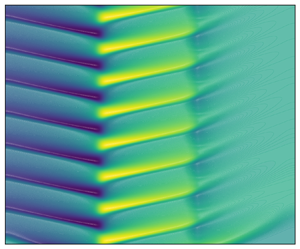Crossref Citations
This article has been cited by the following publications. This list is generated based on data provided by
Crossref.
Castellanos, R.
Cornejo Maceda, G. Y.
de la Fuente, I.
Noack, B. R.
Ianiro, A.
and
Discetti, S.
2022.
Machine-learning flow control with few sensor feedback and measurement noise.
Physics of Fluids,
Vol. 34,
Issue. 4,
Varela, Pau
Suárez, Pol
Alcántara-Ávila, Francisco
Miró, Arnau
Rabault, Jean
Font, Bernat
García-Cuevas, Luis Miguel
Lehmkuhl, Oriol
and
Vinuesa, Ricardo
2022.
Deep Reinforcement Learning for Flow Control Exploits Different Physics for Increasing Reynolds Number Regimes.
Actuators,
Vol. 11,
Issue. 12,
p.
359.
Viquerat, J.
Meliga, P.
Larcher, A.
and
Hachem, E.
2022.
A review on deep reinforcement learning for fluid mechanics: An update.
Physics of Fluids,
Vol. 34,
Issue. 11,
Shinde, Saurabh
and
Bali, Harneet Singh
2022.
Instructions with Complex Control-Flow Entailing Machine Learning.
p.
33.
2023.
How to control hydrodynamic force on fluidic pinball via deep reinforcement learning.
Physics of Fluids,
Vol. 35,
Issue. 4,
Gkimisis, Leonidas
Dias, Bruno
Scoggins, James B.
Magin, Thierry
Mendez, Miguel A.
and
Turchi, Alessandro
2023.
Data-Driven Modeling of Hypersonic Reentry Flow with Heat and Mass Transfer.
AIAA Journal,
Vol. 61,
Issue. 8,
p.
3269.
Vignon, C.
Rabault, J.
and
Vinuesa, R.
2023.
Recent advances in applying deep reinforcement learning for flow control: Perspectives and future directions.
Physics of Fluids,
Vol. 35,
Issue. 3,
Masclans, Núria
Vázquez-Novoa, Fernando
Bernades, Marc
Badia, Rosa M.
and
Jofre, Lluís
2023.
Thermodynamics-informed neural network for recovering supercritical fluid thermophysical information from turbulent velocity data.
International Journal of Thermofluids,
Vol. 20,
Issue. ,
p.
100448.
Yu, Tao
Wu, Xiaoxiong
Yu, Yang
Li, Ruizhe
and
Zhang, Hao
2023.
Establishment and validation of a relationship model between nozzle experiments and CFD results based on convolutional neural network.
Aerospace Science and Technology,
Vol. 142,
Issue. ,
p.
108694.
Vignon, Colin
Rabault, Jean
Vasanth, Joel
Alcántara-Ávila, Francisco
Mortensen, Mikael
and
Vinuesa, Ricardo
2023.
Effective control of two-dimensional Rayleigh–Bénard convection: Invariant multi-agent reinforcement learning is all you need.
Physics of Fluids,
Vol. 35,
Issue. 6,
Xu, Da
and
Zhang, Mengqi
2023.
Reinforcement-learning-based control of convectively unstable flows.
Journal of Fluid Mechanics,
Vol. 954,
Issue. ,
Sirignano, Justin
and
MacArt, Jonathan F.
2023.
Deep learning closure models for large-eddy simulation of flows around bluff bodies.
Journal of Fluid Mechanics,
Vol. 966,
Issue. ,
Liu, Xuemin
and
MacArt, Jonathan F.
2024.
Adjoint-based machine learning for active flow control.
Physical Review Fluids,
Vol. 9,
Issue. 1,
Jia, Wang
and
Xu, Hang
2024.
Optimal parallelization strategies for active flow control in deep reinforcement learning-based computational fluid dynamics.
Physics of Fluids,
Vol. 36,
Issue. 4,
Kim, Innyoung
Jeon, Youngmin
Chae, Jonghyun
and
You, Donghyun
2024.
Deep Reinforcement Learning for Fluid Mechanics: Control, Optimization, and Automation.
Fluids,
Vol. 9,
Issue. 9,
p.
216.
Liu, Yanting
Deng, Nan
Noack, Bernd R.
and
Wang, Xin
2024.
The fluidic pinball with symmetric forcing displays steady, periodic, quasi-periodic, and chaotic dynamics.
Theoretical and Computational Fluid Dynamics,
Vol. 38,
Issue. 2,
p.
203.
He, Chuangxin
Zeng, Xin
Wang, Peng
Wen, Xin
and
Liu, Yingzheng
2024.
Four-dimensional variational data assimilation of a turbulent jet for super-temporal-resolution reconstruction.
Journal of Fluid Mechanics,
Vol. 978,
Issue. ,
Cornejo Maceda, Guy Y.
Jiang, Zhutao
Lusseyran, François
and
Noack, Bernd R.
2024.
Fast Self-Learning of Turbulence Feedback Laws Using Gradient-Enriched Machine Learning Control.
p.
495.
Ishize, Takeru
Omichi, Hiroshi
and
Fukagata, Koji
2024.
Flow control by a hybrid use of machine learning and control theory.
International Journal of Numerical Methods for Heat & Fluid Flow,
Vol. 34,
Issue. 8,
p.
3253.
Ren, Kai
Gao, Chuanqiang
Xiong, Neng
and
Zhang, Weiwei
2024.
Adaptive control of transonic buffet and buffeting flow with deep reinforcement learning.
Physics of Fluids,
Vol. 36,
Issue. 1,



